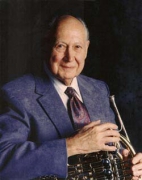Awards
- Distinguished Professor (Emeritus) - 1980

Farkas was born in Chicago in 1914. At age twelve, he joined a Boy Scout troop and became a bugler. By 13, his father rented a Schmidt horn and Farkas quickly declared that he wanted to be a professional horn player. He began studying horn under the tutelage of Earl Stricker. In 1930, he played in the band and orchestra at Calumet High School, and was a member of the All-Chicago High School Orchestra. He began private lessons with the renowned Louis Dufrasne, and joined the Chicago Civic Orchestra.
Farkas became first horn player in the Kansas City Philharmonic in 1933. In 1936, he became first horn in the Chicago Symphony Orchestra, where he earned the distinction of being the youngest member of the orchestra. He went on to play first horn with the Cleveland Orchestra (1941-1945), the Boston Symphony Orchestra (1945-1946), Cleveland Orchestra (1946-1947), and back to Chicago (1948-1960).
He taught horn at the Kansas City Conservatory, Cleveland Institute, DePaul University, Roosevelt University, Northwestern University, and at Indiana University. During his years at IU, Farkas played with the American Woodwind Quintet. He spent his summers playing in the Aspen Festival Orchestra.
Having published The Art of French Horn Playing, a fixture in nearly every horn player's library, Farkas had built a phenomenal reputation as a teacher.
Among his noted accomplishments was the design of the Farkas Model horn and mouthpiece. Farkas spent his entire life experimenting with horn and mouthpiece design. In 1947 he and trumpeter Renold Schilke co-founded a business called Music Products, Inc. through which they produced and marketed horn mouthpieces. After beginning a collaboration with Holton and moving to Indiana University, he sold his share of the business to Schilke, and helped design a collection of mouthpieces for Holton.
Farkas was a co-founder of the International Horn Society (IHS) and received an honorary doctorate from Eastern Michigan University in 1978. Long after his retirement from Indiana University in 1982, he continued to perform and teach in horn clinics.